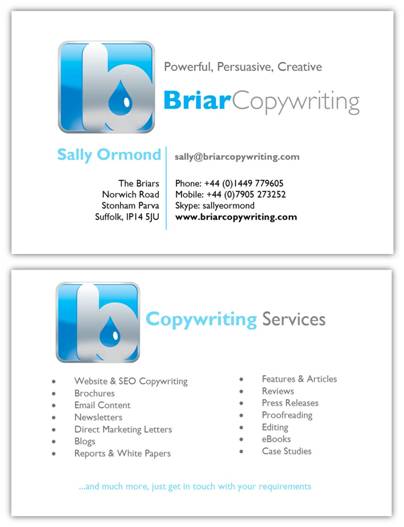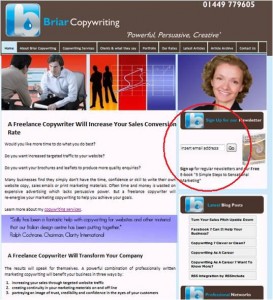Entries Tagged 'freelance copywriter' ↓
September 8th, 2010 — conversion, copywriter, copywriting tips, freelance copywriter, SEO copywriter, seo website copywriter

One of the hottest debates in the SEO copywriting world is word count.
As a freelance copywriter, I have worked on many SEO copywriting projects. Many are direct with my clients others are for SEO web designers and companies. Most clients realise that I know quite a lot about SEO copywriting and in particular how it works. I have written copy for many sites that rank on the front page of Google for their chosen keywords – not least my own website which is on the front page of Google for ‘copywriter’ (out of about 6 million results). So as SEO copywriters go, I’m pretty good – even if I do say so myself.
Of course, that’s not to say my clients’ success is totally down to my writing. Obviously it plays a big part in it, but other off page factors such as link building are also a major contributing factor.
But anyway, back to SEO copywriting.
Most of my clients leave me to it when it comes to writing copy for them. They know I’ll come up with something that will not only help them rank well, but will also convert visitors into sales.
However, many SEO companies that I work for are fixated on word count. When talking about SEO copywriting, phrases such as density and word count probably impress clients, but I have a real problem with them, especially word count. There is a saying in the copywriting world that basically goes:
Copy is as long as it needs to be
As soon as you start placing limits on its length problems start.
Word Count Won’t Affect Your Rankings
I’m about to make a bold statement – there is no evidence whatsoever to support the thinking that more words will result in greater ranking success.
Despite this, I am often asked by designers to produce a specific number of words per web page (usually in the realms of 500 to 600 words). The copy may well call for that number of words but, if it doesn’t, imposing a limit on words plays havoc with my creativity.
The truth is the copy has to be led by the product or service it is to sell. There are web pages with as few as 70 words that rank just as well as pages with 600+ words. There is no rhyme or reason to it. But what matters is that I am not forced to work within strict boundaries.
If I have to write 700 words, but the product or page subject matter only calls for 300, the remaining 400 words are just going to be padding. And that’s bad.
Every word on the web page has to be there for a reason, and that reason is to sell. As I mentioned earlier, your rankings are not going to be just down to words, there are many other factors that will determine how well your site performs (site navigation, META tags, ALT tags, link building…).
Plus you have to think about the reader. How many people are really willing to sit and read a web page that is 600+ words long? Not many. For most people, if you haven’t convinced them within 200 words you’ve lost them.
So what I’m saying is don’t commission me to write a certain number of words for you; commission me to write fantastic SEO website copy that is interesting to the reader, sells the product and converts web traffic into sales – because….
It’s the quality that counts
As with many things in life, it’s the quality that counts, not how much of it you’ve got.
It’s very rare to find a web page that contains mountains of text that is actually interesting all the way to the very end.
Time is a rare commodity these days so people don’t want to be reading the equivalent of ‘War and Peace’ just to find out whether your product/service is for them. They need to find answers quickly – something short copy is very good at.
The effectiveness of the copy must be measured by its conversion rate. A niche market will mean low levels of traffic, but if that traffic has a 100% conversion rate you’re laughing. Your web copy is there to target a specific audience. If it does it’s job, the traffic it brings will convert. After all, what’s the point of having 1000s of visitors a day to your website if your copy doesn’t convert them?
Why you need to know this
Imposing word limits is counter productive. It will either force your copywriter to pad with unnecessary words or they’ll have to ruthlessly cut their text which could seriously damage its impact. Either way it will lead to ‘unnatural’ copy that, however good your SEO copywriter is, will read strangely having a detrimental effect on your conversion rate.
A good SEO copywriter will understand:
- Conversion
- Keyword usage
- The importance of tags
- The optimum places for keywords
Trust their judgement and leave them free to produce the copy for your website. They naturally arrive at a word count that suits your product or service.
Usain Bolt’s coach wouldn’t impose a time limit the runner isn’t allowed to break, so why clip your copywriter’s wings with word count?
September 6th, 2010 — Business card design, copywriter, freelance copywriter, marketing
Business cards may seem a strange subject to be talking about on a copywriting and marketing blog. After all, can a copywriter help with the creation of business cards?
Well the answer is yes – in a way they can.
It is not very often that the humble business card gets to fulfil its potential. Seen by many as a simple means of leaving their contact details with someone, the business card is in fact a mini marketing tool. A fact that is usually overlooked.
Its layout, contents, strapline and use of space is very important in creating something that is eye-catching and memorable. After all, how many times have you been to a networking event only to return home with a fist full of cards that all look the same? Usually they are plain white with a bit of text on showing a name and contact details. They are instantly forgettable and, sadly, so are the people who they belonged to.
If you want to be remembered, make a mark with your business card.
There are two sides to every story
There are also two sides to every business card. So why do so many people forget to use the space on the back of their cards?
Use it to show the services you offer, your USP, even images of your product.

Above is my business card. As you can see I have used both sides of the card to show not only my contact details but also the services I offer to my clients. That way I avoid the conversation that goes…
“Oh, I didn’t realise you did that as well. If I’d known I would have called you.”
The reverse side of your card can be used for many purposes:
- List of services (as above)
- Images of your products
- Your USP
- An offer
- Your picture
- Testimonials
I’m sure you can probably think of a few more.
Make an impact
As you can see from the above, my business card is fairly plain. But its white background sets off my blue logo and works well.
But business cards don’t have to be white. Utilising colour is another way of generating interest and getting your card (and you) remembered. Whether you go for something soothing and pastle or bold and vibrant, the colours you use can say a lot about your business.
For example, if you are a young and funky design agency, your business card will need to reflect that with bold colours and vivid text or graphics.
The market you are aiming for will be reflected in your colour pallett – heritage colours (burgandy, dark green etc.) for the more serious professions (e.g. Solicitors, Accountants etc.), bright and vibrant colours for ‘cool’ businesses (e.g. Design agencies, IT etc.). Of course that’s not set in stone, I’m sure there are many trendy accountants out there who would benefit from a bright, eye-catching business card design too.
Don’t be square
People often seem to believe that business cards have to be rectangular. That’s not so.
Just because most cards are that shape (yes, including mine), doesn’t mean that’s the way they have to be. Stand out from the crowd by using different dimensions or shapes:

Using a shape that is slightly out of the ordinary is a great way to draw attention to yourself. And, when an unusual shape is coupled with a strong colour, the impact is increased.
Interactive cards
What do I mean by interactive? Well, your business card could fold into an card that stands up. Perhaps it can be folded into a box shape. Maybe it has a slit in it to hold something – the pizza restaurant Zizzi is very good at that. Your bill arrives slotted into a business card.
This makes your card stand out from the crowd and gets you noticed.
So you can see there are lots of ways you can use colour, shape and clever functions to get your card and you noticed.
Where does the freelance copywriter come into all of this?
Well, we may not be designers, but we are very good at coming up with straplines and succinct ways of putting your marketing message across.
This post was inspired by an entry I found on dailyblogggr.com. Here are the 36 brilliant examples of business card designs they identfied. It’s amazing the impact such a small piece of card can have – they really can be a very powerful tool in your marketing armoury.
September 3rd, 2010 — copywriter, freelance copywriter, website copywriter, website copywriting

If you tried to give your customers every piece of information about your business and processes within the body of your website, you’d end up with something confusing, long and incredibly tedious.
That is why the humble FAQ (Frequently Asked Questions) page exists.
It is a simple way to communicate simple pieces of information to your reader quickly. Most websites include one these days because:
- They provide an extra level of support for your customers
- They save you time by posting answers to questions you are constantly asked therefore reducing email and phone calls
- They show you care about your customers by providing them with as much assistance as possible
Of course, for it to be a truly effective page you must ensure you include questions that people want to know the answers to. Look back through your email correspondence with customers and pull out all the questions that crop up time and again.
That’s all well and good, but how do you make sure you write a good FAQ page?
Well these 6 pointers will get you started in the right direction.
6 ways to write a winning FAQ page
1. Forget the fuss
The first thing to remember is that your FAQ page is there simply to provide information. It is not one of your main sales pages. So, although its content should still be clear and informative, it is the content that matters so forget images and other distractions. Make sure it is well written and easy to follow and that there’s no ambiguity.
2. Simplicity is key
Providing an FAQ page and then making it difficult to find answers is rather counter-productive. Make it easy for your user by categorising your Q and As. Cluster all questions relating to similar topics together. That way it will make your customers life much easier because they’ll be able to find the information they need quickly.
3. Information overload
The number of questions and answers you have will depend on your business. Some of you may only have half a dozen or so. But for those who are likely to have ten or more questions, gather all the questions together at the top of your page and link each one to their answer. That way your reader can scan down the list of questions, find the one relevant to them, click on the link and be taken to the answer. This will make it much easier to use than if you merely list all Q and As together so they have to scroll down your mammoth list until they find the one they want.
Just bear in mind though, if you do list your questions and link them to the answers, make sure you provide a ‘return to top’ link at the end of each answer so they can easily return to the top of the page.
4. Start with the easy stuff
Another good way to make sure your list of questions is useful is by placing the simplist and most often asked questions at the top of the list. The more complex questions should then come further down the list.
5. You’re not writing a novel
However tempted you are to write something literary and indepth, keep your answers short and to the point. Now’s not the time to show off your writing skills (in fact, that is something you should never do when writing any type of marketing materials. Your writing should be secondary – it is your marketing message that should be noticed), keep your answers simple, short and to the point.
6. Be available
One thing that really bugs me are websites without any contact details. It is so frustrating especially when the FAQ page doesn’t answer my particular problem. Like many people, if I find a site that makes it virtually impossible to get in touch with the company I’ll hit the back browser and find someone else. My instant reaction is what are they trying to hide? If you are a genuine company why isn’t your address, phone number, email address clearly marked on your website? Make sure you provide a link to your contact page from the FAQ page in case someone has a question that’s not listed.
So as you can see your FAQ page really is important and shouldn’t be thrown together as an after thought. It is your extended online customer service portal providing information that your customers need. By making it easy to find, easy to follow and easy to read, you are adding another layer of customer service. Plus, just think of how many emails and phone calls you won’t have to field because your customers can find the answers to their questions for themselves.
Remember to also keep it updated. It is unlikely you’ll predict every question you’ll ever be asked, so as new questions arise add them to your page. Over time you’ll accumulate a valuable bank of information for your customers.
September 1st, 2010 — copywriter, freelance copywriter, search engine optimisation, SEO copywriter, seo website copywriter
 Yes, I’ve returned to my favourite topic – good old search engine optimisation.
Yes, I’ve returned to my favourite topic – good old search engine optimisation.
What makes me so qualified to talk about it?
Am I an SEO expert? – No.
But, I am a great SEO Copywriter – what makes me so sure? Well, that could have something to do with my website appearing on the front page of Google for the term copywriter which is incredibly competitive (getting on for 7 million search results) as well as several of my other keywords.
OK, that’s my credentials out the way, so let’s get back to the subject in hand.
Writing content that is search engine friendly involves far more than stringing a bunch of words together which include your keywords. Below are 7 things you have to know about SEO content if yours is going to work:
1. The importance of content
Writing great content shouldn’t just be about rankings. If that is what you hone in on, you’ll end up writing drivel. Your content has to be interesting and relevant because not only do you want it to rank well in the search results, you also want other people to link to your site and share its information. And we’re not just talking about web copy here, it’s also things like articles and blog posts too. These back links are very important to your SEO strategy so attracting them is vital.
Obviously when writing your content you will have to include your keywords, but do it in a natural way. Don’t cram your copy with them or have them so concentrated it makes it impossible to read. Read your copy out loud, if you find you’re falling over yourself because you have so many keywords, cut them back or re-write it so they are more naturally spaced. Readability is everything.
2. Attention grabbing
Headlines are a great way to grab your readers attention. You obviously want them to be relevant to your copy, but don’t just write decriptive headlines. Think of yourself as a journalist. How would they create a sensational headline to make your reader want to learn more? Try to come up with something that will really capture their imagination and, of course, make sure your primary keyword is in there too.
3. Bionic bio
When you write articles, blog posts or directory submissions, you will be asked for a biography. Again make this as interesting as you can and make sure your keyword is in there.
4. META
META descriptions are often overlooked. They never seem to be thought of as important. But they are. If you are unsure what a META description is, it’s basically 150 characters that are used to describe your content. Include your keywords so your reader can instantly see whether your content is going to be relevant to them or not. Although this may not necessarily directly contribute to your SEO, it will help direct readers to your website.
5. Layout
Just as you would take time to make sure your business letters are laid out correctly, spend the same amount of time ensuring your web copy, articles and blogs are laid out effectively. Lots of white space make them more appealing to the eye and easier to read. Headings and sub headings should be used to attract attention and direct readers through your text. When you use headings, make sure you use the correct tags and in a hierarchical order. H1 tags are your main headings; your sub headings should be H2 etc. And of course, always use your keywords where possible within the headings.
6. Be original
Coming up with continuous and original copy isn’t easy and the temptation to recycle is great. But don’t – unless you want to fall foul of Google’s duplicate content trap, make sure all your content is original. That’s not just your web copy, articles and blog posts, but also directory submissions, biographies and profiles. It is a lot of work but well worth it.
7. Pretty pictures
Finally I want to look at pictures. Images are always a great way to enhance your copy. But make sure the images are relevant to your content and that you have the right to use them. Many people over look the SEO potential of images. The ALT tag is very important as it gives you another opportunity to include your keyword within your site. But make sure the description you use is relevant to the image.
Why do you need to know this?
Many people believe SEO is all down to keywords and content. In part it is, but your SEO strategy should encompass so much more. You have to think about readability, links, images as well as the navigability of your website (for humans and search engine spiders).
Too many companies are still spending thousands on websites without giving a thought to its content. Yes a well designed site is important, but it is the words within it that will do the hard work for your rankings, attract traffic and convert those visitors into paying customers.
If you think SEO copywriting is an expense you can do without, you may as well think customers are an unnecessary annoyance. Investing in well written SEO copywriting is vital for the success of your online marketing.
It won’t be cheap but it will make a huge difference to your bottom line.
Sally Ormond is an international SEO Copywriter. She has worked with numerous companies (SMEs to Blue Chip Companies) from a broad range of industries to create eye-catching SEO website copy that attracts a targeted audience and converts them to buying customers. Find out how you can benefit from her experience by getting in touch today.
August 30th, 2010 — copywriter, email copywriting, email marketing, freelance copywriter, marketing
 Email marketing is possibly the most important and effective marketing tool available to businesses today. It offers a way of regularly communicating with your customers to give them up to date information, telling them about new products and offers. Within seconds you can communicate with thousands of customers simultaneously – and that’s very powerful.
Email marketing is possibly the most important and effective marketing tool available to businesses today. It offers a way of regularly communicating with your customers to give them up to date information, telling them about new products and offers. Within seconds you can communicate with thousands of customers simultaneously – and that’s very powerful.
I have written numerous posts about email marketing in the past, such as:
How to build your email marketing list
Email marketing – Welcome
How to be an email spammer
How to become the King or Queen of email marketing
Consistent email marketing
10 words that will make people open your email
Email marketing – When’s the best time to send?
Boost your email open rate
So this time I want to address a question I am frequently asked by clients…
How often should I email my customers?
As we all know life is rarely simple, so you can probably guess what my answer is going to be….it depends.
Not very helpful I know, but it really does depend on your business type. What’s right for one person isn’t necessarily going to be right for the next. You have to find the right balance for you. Take a good look at your business and the products or services you offer – the frequency of your emails will dependly largely on:
- What you are offering your customers
- Who your customers are
- What you have to say
Common frequencies are quarterly, monthly, bi-monthly (i.e. once every two months), twice monthly, weekly and sometimes daily (or multiple times per day).
To help you out, here is a short guide to email frequency:
Quarterly
The businesses that opt for a quarterly mailing usually don’t have a vast amount to say. Perhaps their products or services don’t change regularly and they don’t have offers to make. Although some would argue some contact is better than none, I struggle to see the point of only making contact once a quarter. By leaving so much time between communications you run the risk the recipient forgetting who you are.
To be quite honest, if you are considering quarterly mailings I would think very hard about it. There’s almost no point in bothering.
Monthly
Many companies go for the monthly option because it is regular without seeming intrusive. Often the businesses who opt for this frequency don’t use their newsletter/email to sell things. Normally they are more concerned with imparting valuable knowledge on the recipient. Giving away great information regularly is an excellent way to build and strengthen relationships with your customers.
As a copywriter I send out a monthly newsletter which offers my readers hints and tips on copywriting, marketing and social media. It is free information that I am giving away and I never sell through it. By the way, if you want to get on the mailing list visit my website and sign up.

Twice a month
This is a compromise for those companies that want to make contact more than monthly but don’t have enough to say to make weekly contact. One of the benefits of this frequency is you can alternate the type of content you email. One could be giving away information whilst the next could be an offer on one of your products. That way your reader won’t feel as though they are constantly being sold to.
Weekly
Weekly emails are often sent by stores looking to sell. Whether they are High Street chains or independent shops, weekly emails enable them to communicate offers and new lines quickly and easily to their customers. Plus being retail outlets it won’t come as a surprise to the recipient that they are being sold something.
So these are the most common frequencies used. There are companies that email daily or even multiple times per day but you’d have to have a lot to say to be able to keep that up.
Keeping up with your chosen frequency is important. Your customers will grow to expect their next newsletter/email so if you have to miss one for any reason (e.g. holiday etc.) make sure you let them know. Just a simple one liner to say there’ll be no newsletter this month but service will resume as usual next month will keep them informed.
If you are not already doing it, give email marketing a try. Coming up with a constant stream of ideas and content can be a challenge, but the results make it worth while.
Sally Ormond – freelance copywriter




 Yes, I’ve returned to my favourite topic – good old search engine optimisation.
Yes, I’ve returned to my favourite topic – good old search engine optimisation. Email marketing is possibly the most important and effective marketing tool available to businesses today. It offers a way of regularly communicating with your customers to give them up to date information, telling them about new products and offers. Within seconds you can communicate with thousands of customers simultaneously – and that’s very powerful.
Email marketing is possibly the most important and effective marketing tool available to businesses today. It offers a way of regularly communicating with your customers to give them up to date information, telling them about new products and offers. Within seconds you can communicate with thousands of customers simultaneously – and that’s very powerful.





